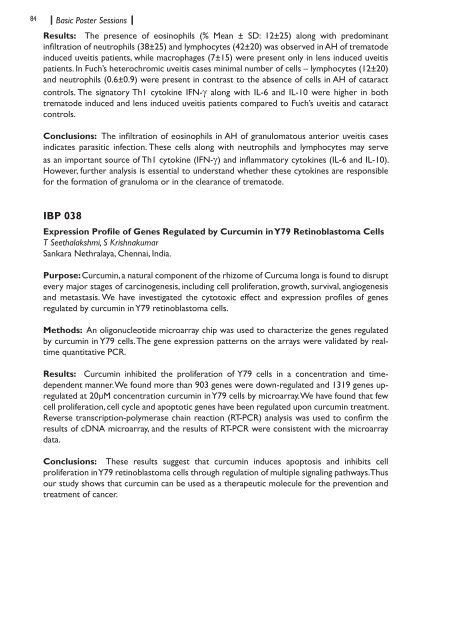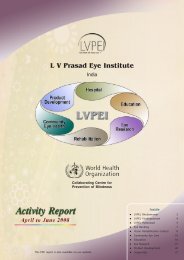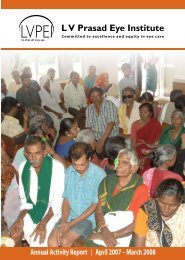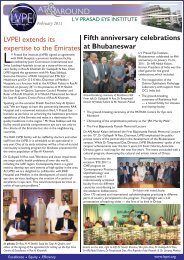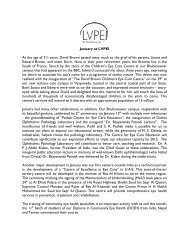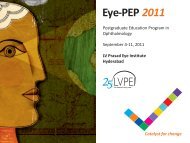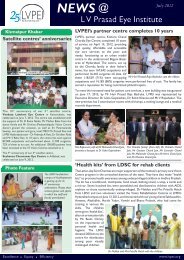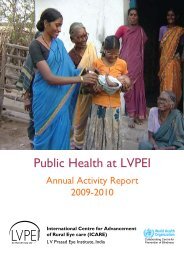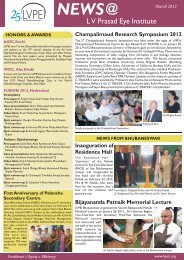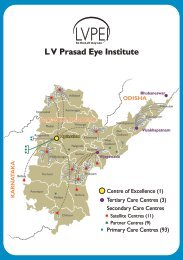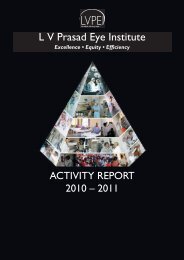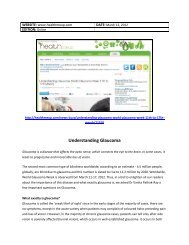IERG Abstracrt Book.indd - LV Prasad Eye Institute
IERG Abstracrt Book.indd - LV Prasad Eye Institute
IERG Abstracrt Book.indd - LV Prasad Eye Institute
You also want an ePaper? Increase the reach of your titles
YUMPU automatically turns print PDFs into web optimized ePapers that Google loves.
84 Basic Poster SessionsResults: The presence of eosinophils (% Mean ± SD: 12±25) along with predominantinfiltration of neutrophils (38±25) and lymphocytes (42±20) was observed in AH of trematodeinduced uveitis patients, while macrophages (7±15) were present only in lens induced uveitispatients. In Fuch’s heterochromic uveitis cases minimal number of cells – lymphocytes (12±20)and neutrophils (0.6±0.9) were present in contrast to the absence of cells in AH of cataractcontrols. The signatory Th1 cytokine IFN-g along with IL-6 and IL-10 were higher in bothtrematode induced and lens induced uveitis patients compared to Fuch’s uveitis and cataractcontrols.Conclusions: The infiltration of eosinophils in AH of granulomatous anterior uveitis casesindicates parasitic infection. These cells along with neutrophils and lymphocytes may serveas an important source of Th1 cytokine (IFN-g) and inflammatory cytokines (IL-6 and IL-10).However, further analysis is essential to understand whether these cytokines are responsiblefor the formation of granuloma or in the clearance of trematode.IBP 038Expression Profile of Genes Regulated by Curcumin in Y79 Retinoblastoma CellsT Seethalakshmi, S KrishnakumarSankara Nethralaya, Chennai, India.Purpose: Curcumin, a natural component of the rhizome of Curcuma longa is found to disruptevery major stages of carcinogenesis, including cell proliferation, growth, survival, angiogenesisand metastasis. We have investigated the cytotoxic effect and expression profiles of genesregulated by curcumin in Y79 retinoblastoma cells.Methods: An oligonucleotide microarray chip was used to characterize the genes regulatedby curcumin in Y79 cells. The gene expression patterns on the arrays were validated by realtimequantitative PCR.Results: Curcumin inhibited the proliferation of Y79 cells in a concentration and timedependentmanner. We found more than 903 genes were down-regulated and 1319 genes upregulatedat 20µM concentration curcumin in Y79 cells by microarray. We have found that fewcell proliferation, cell cycle and apoptotic genes have been regulated upon curcumin treatment.Reverse transcription-polymerase chain reaction (RT-PCR) analysis was used to confirm theresults of cDNA microarray, and the results of RT-PCR were consistent with the microarraydata.Conclusions: These results suggest that curcumin induces apoptosis and inhibits cellproliferation in Y79 retinoblastoma cells through regulation of multiple signaling pathways. Thusour study shows that curcumin can be used as a therapeutic molecule for the prevention andtreatment of cancer.


